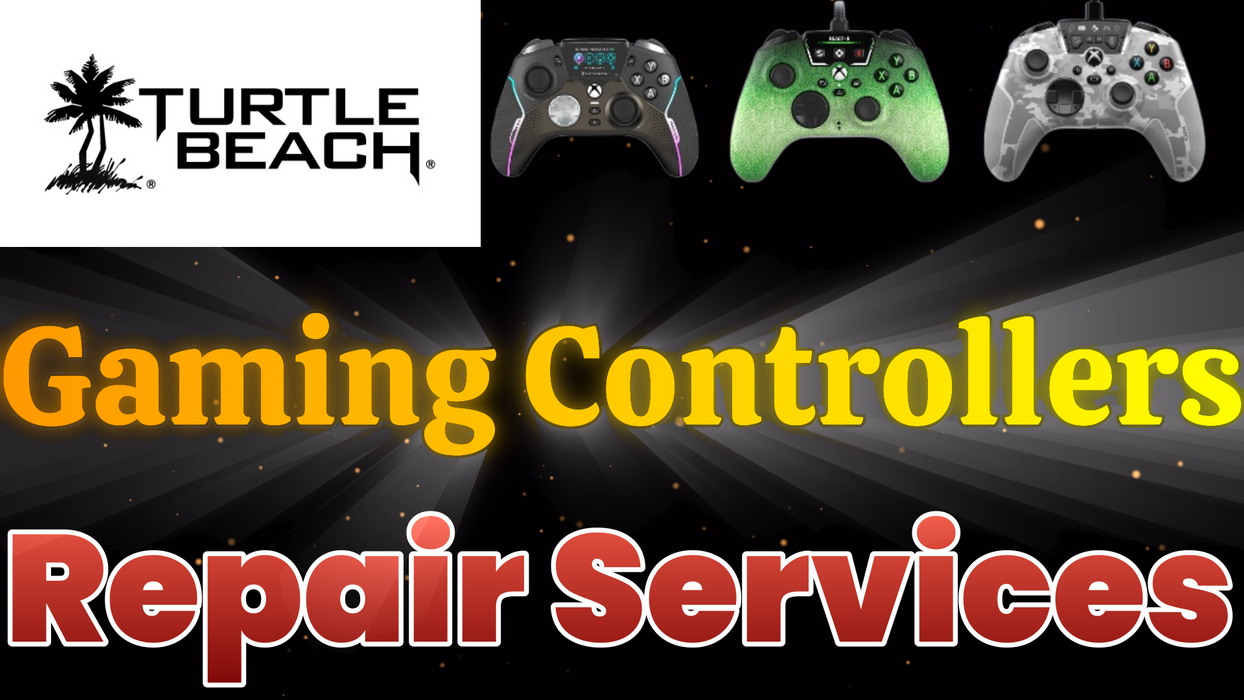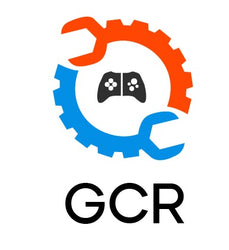

TurtleBeach Gaming Controller Repairs
Get a FREE Quote
Turtle Beach is known for its high-quality gaming peripherals, including gaming controllers, but like any electronics, they can experience issues over time. Below are common problems associated with Turtle Beach gaming controllers and their potential solutions:
1. Button Unresponsiveness
- Problem: Buttons fail to register inputs or require excessive pressure to function.
- Cause: Worn-out button contacts, debris buildup under the buttons, or faulty circuitry.
- Solution: Clean the button contacts with isopropyl alcohol. If the problem persists, the internal membrane or button contacts may need to be replaced.
2. Stick Drift (Analog Stick Issues)
- Problem: The analog sticks cause unintended movement in games, even when not being touched.
- Cause: Dust or debris inside the analog stick, or worn-out potentiometers in the stick mechanism.
- Solution: Clean around the analog sticks using compressed air or contact cleaner. If the drift continues, replacing the analog stick module may be necessary.
3. Trigger Malfunctions
- Problem: Triggers (L2/R2) are either unresponsive, stuck, or fail to return to their neutral position.
- Cause: Broken trigger mechanism, worn-out springs, or internal damage.
- Solution: Open the controller and inspect the trigger mechanism for broken parts or debris. Replace the trigger or springs if necessary.
4. Vibration Motor Failure
- Problem: The controller’s vibration (rumble) feature doesn’t work or is inconsistent.
- Cause: Disconnected or faulty vibration motors, or worn-out internal wiring.
- Solution: Open the controller and check if the vibration motors are properly connected. Replace damaged motors if needed.
5. Connectivity Issues (Wireless Models)
- Problem: Wireless controllers experience connection drops or fail to connect to the console.
- Cause: Battery issues, Bluetooth interference, or outdated firmware.
- Solution: Ensure the controller is fully charged, re-pair the controller, and update the firmware if available. Check for potential wireless interference from other devices.
6. Battery Drain Issues
- Problem: The controller’s battery drains quickly or doesn’t hold a charge.
- Cause: A degraded battery, faulty charging port, or power management issues.
- Solution: Replace the internal battery or check the charging port for damage. If the charging port is damaged, it may need to be repaired or replaced.
7. D-Pad Issues
- Problem: The D-pad doesn’t register inputs properly or feels unresponsive.
- Cause: Worn-out contacts beneath the D-pad or debris affecting functionality.
- Solution: Clean the D-pad and its contacts. If cleaning doesn’t help, the D-pad mechanism or membrane might need to be replaced.
8. Worn Grips
- Problem: The grips on the sides of the controller become loose, worn out, or uncomfortable.
- Cause: Natural wear and tear from prolonged usage.
- Solution: Replace the grips with new ones or apply grip covers for better comfort and durability.
9. Headphone Jack Not Working
- Problem: The 3.5mm audio jack for headsets stops working, or the audio quality is poor.
- Cause: Dust buildup or a damaged audio jack.
- Solution: Clean the headphone jack with compressed air or isopropyl alcohol. If this doesn’t fix the problem, the audio jack may need to be replaced.
10. Firmware Compatibility Issues
- Problem: After a firmware or console update, the controller experiences lag or malfunctions.
- Cause: Outdated controller firmware that may no longer be compatible with updated consoles.
- Solution: Update the controller firmware using the manufacturer’s software. In some cases, resetting the controller to factory settings may resolve the issue.
11. No Power or Failure to Turn On
- Problem: The controller does not power on or turns off unexpectedly.
- Cause: Battery issues, faulty power button, or internal circuit problems.
- Solution: Replace the battery if it's not charging or holding power. Inspect and repair the power button or internal wiring if the problem persists.
12. Latency or Input Lag
- Problem: Delay between button presses and in-game actions, making gameplay difficult.
- Cause: Wireless interference, low battery, or outdated firmware.
- Solution: Ensure the controller is fully charged, reduce wireless interference, and update firmware if available. Switching to a wired connection can also reduce input lag.
13. Loose or Broken Internal Wiring
- Problem: The controller randomly disconnects or fails to function properly.
- Cause: Internal wires may have become loose or damaged from wear and tear.
- Solution: Open the controller and carefully inspect the wiring for loose or broken connections. Re-solder or replace damaged wires as necessary.
14. Joystick Dead Zones
- Problem: The joystick has a large dead zone, requiring significant movement before input is registered.
- Cause: Calibration issues or worn-out sensors in the joystick mechanism.
- Solution: Recalibrate the joystick through the console’s settings. If recalibration doesn’t work, the joystick module may need replacement.
15. Shoulder Button Failure
- Problem: L1/R1 buttons are unresponsive or have a delayed response.
- Cause: Worn-out button contacts or broken internal components.
- Solution: Clean the internal mechanism of the shoulder buttons. If the issue persists, replacing the buttons or their contacts may be necessary.
16. Charging Port Damage (Wireless Models)
- Problem: The controller doesn’t charge, or the charging cable is loose.
- Cause: Damaged or worn-out charging port.
- Solution: Inspect the charging port for visible damage. If necessary, replace the charging port.
17. Overheating
- Problem: The controller gets hot during extended use.
- Cause: Prolonged usage or internal electrical issues.
- Solution: Allow the controller to cool down and check for any internal short circuits. If the issue continues, internal components may need inspection or replacement.
18. Physical Damage
- Problem: The controller casing is cracked, buttons are damaged, or internal components are loose due to dropping or impact.
- Cause: Physical trauma to the controller.
- Solution: Replace the damaged casing or internal parts. In severe cases, the controller may need professional repair.
19. Calibration Issues
- Problem: The controller is misaligned, and in-game actions don’t correspond to the inputs.
- Cause: Calibration drift over time or due to firmware updates.
- Solution: Recalibrate the controller using the system’s built-in tools or third-party software.
20. Software or Game Compatibility
- Problem: Some buttons or features don’t work properly with specific games.
- Cause: Software or game compatibility issues with the controller.
- Solution: Ensure the game and controller are compatible. Adjust settings in the game or console for controller mapping.
Summary
Turtle Beach gaming controllers are reliable but can face issues like stick drift, button unresponsiveness, connectivity problems, and trigger malfunctions. Many problems can be solved with regular cleaning, recalibration, firmware updates, and replacement of faulty parts. For more complex issues, professional repair may be required.
If unable to resolve the issue with your Logitech Gaming Controller, book now and let us get your controller up and running in no time
Product Reviews
Add customer reviews and testimonials to showcase your store's happy customers.
Author's name
Add customer reviews and testimonials to showcase your store's happy customers.
Author's name
Add customer reviews and testimonials to showcase your store's happy customers.
Author's name
